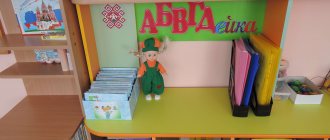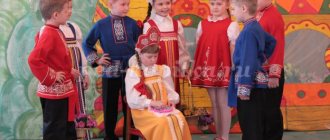Presentation “Introduction to the theater” presentation for the lesson (senior group) on the topic
Conversation for the virtual trip “Getting to know the theater.”
Goal: To develop interest in the theater and theatrical activities.
Tasks:
- Expand children's knowledge about theater as a type of art;
- Strengthen your knowledge of theaters;
- Continue to introduce theatrical terminology (actor, director, lighting designer, costume designer, make-up artist);
- Activating children's speech through the development of dialogic conversation, introducing new words and concepts into the active vocabulary (Foyer, spotlights);
- Fix the text of S. Marshak’s poem “In the Theater for Children”;
- To consolidate knowledge of the professions of people serving in the theater;
- Foster a culture of communication between children, children and adults;
- Continue to develop the ability to comply with the rules of behavior in the theater.
Material: electronic presentation “Getting to know the theatre.”
Preliminary work: looking at photographs of the theater.
Activation of the dictionary: wardrobe, cloakroom attendant, foyer, usher, orchestra pit, director, actor, role, prop man, make-up artist, applause, costume designer, artist, cashier. Progress of the conversation:
Educator: Children, today we will talk about the theater. What is theater?
Children: The theater is an amazing house where they show performances, fairy tales, where they dance and sing, and recite poems.
Educator: Guys, have you been to a real theater?
Children: No.
Educator: Why do you think people go to the theater?
Children: Adults and children go to the theater to watch a play, a fairy tale, listen to music, learn new things, and relax.
Educator: Every visit to the theater is a holiday! The word THEATER came to us from the Greek language and means “place for spectacle, spectacle.” But theater is not only an art form, but also a building where we come to performances. Want to know more about theatre? Children: Yes. Educator: Let's go to the theater. And I will be your tour guide. I invite you on a tour! Slide 1 INTRODUCTION TO THE THEATER Educator: Theaters come in different genres: theaters in which the actors do not talk, but sing, and their singing, stage action and actions are consistent with music written specifically for this play - this is opera.
Slide 2 OPERA AND BALLET THEATER
Slide 3 OPERA In opera they do not speak, but sing. What an opera singer sings is called an aria.
Theaters in which the actors do not talk, but dance, and all feelings are expressed through dance movements - this is ballet. Slide 4 BALLET Ballet dancers tell the audience about all the events and relationships of the characters with each other through dance.
Slide 5 Many wonderful operas and ballets are based on fairy tales. Alice in Wonderland The Nutcracker The Tale of Tsar Saltan
Slide 6 DRAMATIC THEATER In a drama theater, actors talk. The playwright talks about the characters and events in the play through dialogues.
Slide 7 THEATER OF ANIMALS
The oldest theater exists in Moscow - the theater of V. L. Durov. “Grandfather Durov’s Corner” where animals perform: hippopotamus, elephant, raven, pelican, raccoon and many others.
Slide 8 PUPPET THEATER There are puppet theaters where spectators look not at live actors, but at puppets controlled by the artists. Slide 9 GLOVE DOLLS Slide 10 PUPPETS
Slide 11 SHADOW THEATER
Slide 12 FOYER
Slide 13 AUDITORIUM Let's look at the auditorium. The most important place in the auditorium is the stage on which the performance is performed. The scene itself is not yet visible. It is still closed with a curtain. If you are sitting far from the stage, you will need theater binoculars, which you can bring with you or purchase from the cloakroom. PARTERRE BENOIR MEDIUM FLOORS 1st TIERC 2nd TIERC BALCONY
Slide 14 ORCHESTRA PIT. Musical operas and ballets, in opera the artists sing, they are called soloists, and they are assisted by choreographers and an orchestra. The orchestra is led by a conductor so that the musicians play in the same rhythm and tempo, and in ballet the artists dance. A choreographer helps them in staging the dance. The musicians are sitting in the orchestra pit. The orchestra pit is a special room for the orchestra in the theater, located in front of the stage.
Slide 15 CURTAIN What is a theater curtain? This is a canvas that covers the stage from the audience. The performance will begin as soon as the curtain rises or moves apart, as they are sliding or rising.
Slide 16 DECORATIONS The scenery for the performance is made in the workshop according to the sketches of the decorative artists.
Slide 17 The scenery for the performance is made in the painting and decoration workshop according to the artists’ sketches.
Slide 18 PROPERTIES Props are fake, specially made objects of sculpture, furniture, and dishes used in theatrical performances instead of real things. A theater worker who makes props is called a prop maker. Crockery, food, weapons, and furniture can be props.
Slide 19 SPOTLIGHTS With the help of spotlights, lighting designers can depict a sunrise or sunset, flashes of lightning, a starry sky and much more on stage.
Slide 20 During a performance, a sound engineer can turn on a soundtrack: the sound of rain or the roar of waves, the roar of the crowd or the whistle of the wind - depending on what is happening on stage at that time.
Slide 21 Before the performance, the make-up artist applies makeup to the actors. An experienced master can change an actor's face beyond recognition.
Slide 22 Actors for a performance may need a variety of costumes - ancient, modern, and even fairy-tale. The entire costume must first be designed and then drawn by the artist. The tailors will then bring his ideas to life. Masters can paint a piece of burlap in such a way that from the audience it will seem like rich brocade, velvet or silk.
-And the most important person who runs the whole performance is the director. He chooses which play to stage, assigns roles, organizes and conducts rehearsals and everything that happens on stage.
Slide 23 DIRECTOR The director also chooses which play to stage, works with the production designer, and organizes everything that happens on stage.
Slide 24 Finally, the performance is ready, and the theater invites the audience. The new performance is called the premiere. So, you and I are spectators. The performance will begin soon and it’s time for us to go to the auditorium. But what is it? (Bell) Which of you is the most attentive and heard an unusual sound? This is a theatrical call. In total, the theater rings three bells before the start of the performance. The third bell indicates that the performance is beginning. After the third ring, the lights in the hall go out. It is indecent to enter the auditorium after the third bell.
Slide 25Applause! Educator: Our excursion has come to an end, did you enjoy the trip? Children: Yes. Educator: What did you like most? Let's remember where we've been? What did you see? Well done! You were attentive, it's time to return to kindergarten.
Theater project in the senior group
Play theater should be a constant presence in children's lives. To do this, teachers keep notes on theater activities, where they distribute various types of performances, evenly distributed throughout the academic year.
The results of the lessons in the garden are:
- communicative development of children of different ages;
- familiarization with the history of the origin of the theater and its purpose;
- joint creation of props and stage images;
- increasing parents' attention to the creative activities of preschoolers;
- creating a screen for further use by children in independent theatrical performances.
Making your own actors
The theater design should reflect the needs of children's development in accordance with their age characteristics. Often, children need to give free rein to their imagination to organize their own theatrical performance. So, children 4-5 years old can quite successfully put on a show using only spoons. A healthy imagination is enough to mentally endow each spoon with appearance, character, and create a fictional image. Even at the stage of self-analysis, teachers find out the pupils’ ability to think outside the box, leaving the child, as if by accident, alone at the table with two or three spoons. Some children begin to get bored over time and look in the direction of their frolicking peers, while others, already in the first minute, take up spoons and begin to play with them like dolls.
Aesthetic education in a preschool educational institution
Additional Information! Children who are unable to create instruments for play from everyday objects using their imagination especially need theater, which will allow them to develop non-standard thinking and relieve them of emotional constraint.







